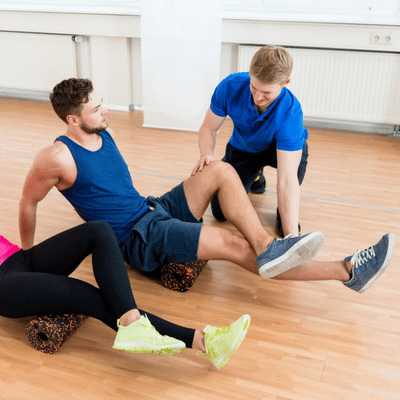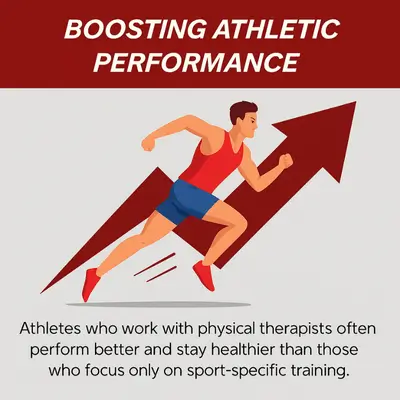Athletes push their bodies to the extreme. Every training session and competition demands maximum effort from muscles, joints, and movement systems, challenging mobility and function. To evaluate athlete’s movement patterns and ensure reduced risk of setbacks, physical therapists guide patients through targeted treatment options. This vigilant approach makes physical therapy for athletes essential for peak performance and health.
Sports physical therapy goes beyond treating injuries after they happen. Physical therapists design rehabilitation programs that shorten recovery, improve joint function, and enhance athlete’s performance. They offer rehabilitation strategies that may avoid surgery, lowering injury risk for active patients. According to the American Physical Therapy Association, physical therapy blends prevention, treatment, and performance enhancement to keep competitors at peak condition.
What Makes Sports Physical Therapy Different

Sports physical therapists understand athletes’ demands. They do more than help people walk; they help athletes jump higher, run faster, sharpen agility, and restore full function. Their focus is on translating sport-specific goals into targeted physical therapy that sustains peak performance.
These specialists hold advanced degrees and education in sports medicine. These physical therapists often earn Sports Clinical Specialist status after passing a certification exam proving mastery of sports injuries. Their training keeps focus on evidence-based care. Some held a master’s in physical therapy, yet the education path ends with a doctorate covering surgery alternatives and second assessment skills.
Sports physical therapists work with movement patterns unique to each sport. A tennis player needs different care than a football player, so physical therapists start with evaluation mapping movement and identifying risk. The focus then shifts to corrective physical therapy drills that lower injury risk, boost agility, and optimize function without disrupting competitions.
Stopping Injuries Before They Start

The best injury is one that never happens. Injury prevention represents the most valuable service sports physical therapy provides. Many sports injuries come from poor movement patterns, muscle imbalances, or training errors that build up over time.
A sports physical therapist will assess an athlete’s movement quality, strength, and flexibility. They look for red flags that signal trouble ahead. Tight hips might lead to knee problems. Weak glutes could cause back pain. Poor shoulder stability might result in throwing injuries.
Injury prevention physical therapists create targeted exercise programs to fix these issues before they cause problems. Research shows that athletes who follow proper warm-up routines and corrective exercises suffer fewer injuries. Some prevention programs cut ACL knee injuries by over 50%.
Balance and core stability training also play key roles in prevention. Athletes with better balance and body control avoid awkward movements that cause injuries. They stay in better position during sports and react faster to unexpected situations.
Getting Athletes Back in the Game
When injuries do occur, sports physical therapy becomes the athlete’s best path for rehabilitation. Injury rehabilitation requires specialized knowledge of sports medicine, healing processes and return-to-play protocols.
Treatment starts with a detailed evaluation of the injury and the athlete’s overall condition. The therapist creates a personalized treatment plan with specific goals and timelines from the assessment. This plan includes exercises to restore strength, flexibility, and mobility in the injured area.
Manual therapy techniques help speed healing and reduce pain. Hands-on methods like joint mobilization and soft tissue massage improve blood flow and reduce inflammation. These techniques enhance tissue healing and can cut recovery times significantly.
Corrective exercises rebuild functional strength, performance, and coordination as healing progresses. The therapist gradually introduces sport-specific drills to prepare the athlete’s body for competition demands. Modern treatment includes electrical stimulation for pain management and muscle activation when needed.
Sports physical therapists also guide return-to-play decisions. They use objective tests to make sure strength, balance, and movement quality meet safe standards before clearing athletes for competition. This careful approach helps prevent future injuries and builds confidence.
Boosting Athletic Performance

Top athletes work with sports physical therapists even when healthy. These specialists can analyze movement patterns and find ways to improve efficiency, power, and agility. Small improvements in technique can lead to enhanced performance.
A therapist might spot a runner’s stride flaw or identify shoulder weakness in a throwing athlete. They then design exercise programs to address these areas. The result might be a faster sprint time, higher jump, or more accurate throw.
Athlete’s performance enhancement combines strength training with movement quality. Athletes learn to move more efficiently while building power and speed. This approach reduces wasted energy and improves results.
The difference shows up in competition. Athletes who work with physical therapists often perform better and stay healthier than those who focus only on sport-specific training. They train smarter and get more from their effort.
Complete Care for Athletes

Sports physical therapy spans athlete care within sports medicine, including prevention of sports injuries. Many physical therapists provide emergency care at events, injury management and treating athletes on the spot. Their quick response reduces injury severity, enhances recovery, and speeds patients back to peak performance.
These specialists educate athletes about proper training methods, rehabilitation techniques, and injury warning signs. Physical therapists design a personalized training program in physical therapy sessions to build mobility and resilience. This knowledge helps athletes and patients make better health decisions, reducing need for surgery.
Sports medicine teams often include physical therapists working with doctors, trainers, and coaches. Some physical therapists with a master’s degree lead evaluation labs, and each professional brings specific skills to support the athlete’s goals with focused physical therapy plans to treat movement deficits. The therapist focuses on movement quality, prevention of injury, and rehabilitation through ongoing physical therapy.
Taking Action for Your Athletic Future
Physical therapy for treating athletes has become essential for modern sports performance. Athletes who use these services get injured less often, recover faster when problems occur, and perform better throughout their careers.
The benefits extend beyond elite competitors. Weekend warriors and recreational athletes also gain from being evaluated by sports physical therapists. Better movement quality and injury prevention strategies help everyone play their best performance while staying healthy.
Allowing athletes to train harder and perform better requires professional guidance. A qualified sports physical therapist can evaluate your movement, identify areas for improvement, and create programs tailored to your goals.
Don’t wait for an injury to start caring for your body. Sports physical therapy represents an investment in your athletic future. With proper care, you can enhance performance, prevent injuries, and enjoy sports for years to come.
Contact a certified sports physical therapist today to learn how physical therapy can transform your athletic performance and keep you in the game.

